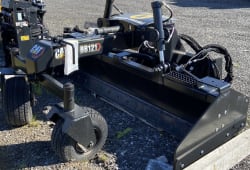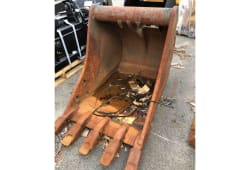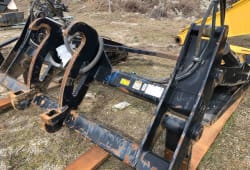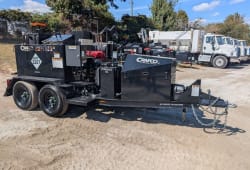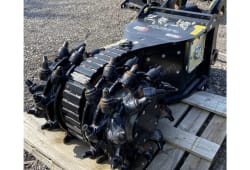Privileges of Using a Sheepsfoot Roller
6 Min read
)
June 30, 2023
Soil compaction is an integral part of construction and infrastructure improvement, and one of the handiest machines in attaining this mission is a sheep's curler. This device has numerous benefits, making it a popular choice amongst contractors, including enhanced load-bearing potential, friendly, and electricity. In this text, we will discover the unique sorts of sheep foot rollers, their blessings in soil compaction, the applications of this device, and how they compare to other kinds of smooth drum rollers.
Understanding Sheepsfoot Rollers
What is a Sheepsfoot Roller?
A sheepsfoot roller is a heavy gadget used in soil compaction. It is known after its cylindrical-formed drum, which has rows of flippantly spaced protrusions that resemble the hooves of a sheep. These protrusions are available in numerous styles and sizes and are designed to create a kneading effect on the soil. This creates greater soil density, increasing its potential to assist better masses and withstand more stress.
A sheepsfoot compactor is commonly utilized in construction projects to compact soil and prepare the ground for building foundations, roads, and runways. It is also used in agriculture to compact soil before planting plants.
How Does a Sheepsfoot Roller Work?
The sheepsfoot roller's protrusions efficiently penetrate the soil even as rolling across it, breaking down any clumps or air wallet that can be present. This guarantees even compaction throughout the floor, resulting in uniform soil density.
Sheepsfoot rollers are ideal for compacting clay soils with higher moisture content and can be more challenging to compact than dry soils. The kneading impact created via the protrusions enables cohesive soil to squeeze out extra water and air, resulting in a more solid and compact surface.
Different Types of Sheepsfoot Rollers
Two number-one sorts of sheep foot rollers are available in the market: static and vibratory. While static sheep foot rollers rely entirely on their weight to attain the necessary compaction pressure, vibratory sheep foot rollers have vibrations that produce a better compaction pressure, making them ideal for compacting hard soils and wet clay.
Vibratory sheep foot rollers use weight and vibration to achieve extra compaction pressure. The vibrations help to interrupt any clumps of sand or air pockets inside the soil, ensuring greater even compaction throughout the entire floor.
Static sheep foot rollers are usually used for smaller projects or in situations where vibration may damage nearby systems. They are also more fuel-efficient because they do not require a vibration mechanism.
Overall, sheep foot rollers are crucial tools in soil compaction, helping to create strong and sturdy surfaces for production and agriculture projects.
Advantages of Sheepsfoot Rollers in Soil Compaction
Improved Load Bearing Capacity
Sheepsfoot rollers offer progressed load-bearing potential, crucial for infrastructure and construction tasks. As the soil density increases, it may resist greater masses without settling, which guarantees the longevity of the undertaking, decreasing the need for upkeep. A Smooth curler is used to compact quality-grained soils, but they do not use tamping toes. The Padfoot roller, referred to as the tamping foot roller, is a compaction equipment that uses tamping toes to compact cohesive soils.
Enhanced Stability and Strength
A nicely compacted soil offers enhanced balance and power, minimizing the risk of soil erosion and other soil-associated troubles. Denser soil also reduces the probability of soil settling, which could result in building damage and other construction issues.
Reduced Settlement and Shrinkage
Sheepsfoot rollers compact the soil uniformly, lowering unwanted agreement and shrinkage inside the soil. This could have a sizable effect on the lifespan of the infrastructure at the activity site, reducing the need for repairs and protection in the future.
Applications of Sheepsfoot Rollers
Road Construction
Road creation is one of the most common packages of sheep foot rollers. The 3-foot curler compacts the soil layer between the sub-base and the surface layer, increasing its density and improving the street's bearing potential. This guarantees the street can resist ordinary usage and decreases the probability of potholes and other floor harm.
Dam and Embankment Projects
Dams and embankments require high degrees of balance and power to resist the sizeable amounts of water they often preserve. Sheepsfoot rollers help increase the density of the soil, present stability, and electricity, and decrease the threat of soil erosion, which can cause catastrophic disasters.
Landfill Compaction
Landfills require proper soil compaction to save your soil settling and reduce odors. Sheepsfoot rollers are very compact substances that are perfect for compacting the landfill's soil layer, ensuring minimum agreement, and improving the landfill's structural integrity.
Single drum rollers and drums are powerful for compacting plastic soils because they apply static pressure to the soil, which enables them to break up the soil debris and distribute it lightly.
Agricultural Land Preparation
Sheepsfoot rollers can help in preparing agricultural land for planting plants. Since the soil needs to be uniformly compacted, the curler may be used to acquire the desired soil density, improving crop yield while minimizing the soil's water loss.
Sheepsfoot Roller vs. Smooth Drum Roller
Key Differences
The number one difference between a sheep foot roller and a clean drum roller is the kind of protrusion on the roller's drum. Sheepsfoot rollers have protrusions that resemble the hooves of a sheep, at the same time as clean drum rollers have a clean, even drum. However, clean drum rollers are best for compacting granular materials, while sheep foot rollers are more applicable for compacting clay soils.
Choosing the Right Roller for Your Project
When choosing the proper roller for your project website, it is essential not to forget to remember the form of soil and the quit desires of the project. Smooth drum rollers are ideal for granular soils and practice of the soil for asphalt, even as sheep foot rollers are suitable for clay soils and attaining excessive soil density.
Conclusion
Overall, sheep foot rollers provide numerous advantages in soil compaction, stepped forward load-bearing ability, more advantageous balance and energy, and reduced agreement and shrinkage. They are beneficial in many packages, from street construction to agricultural land coaching. Compared to smooth drum rollers, sheep foot rollers provide unique blessings and ought to be selected relying on the type of soil and the cease desires of the challenge. By choosing the proper curler, contractors can attain uniformly compacted soil and a lengthy-lasting infrastructure that calls for minimal renovation in the long run.

Samir Shah is the Co-Founder and Chief Product Officer of Boom & Bucket, where he leads the development of innovative solutions for buying and selling heavy equipment. With a background in engineering, product development, and business strategy, Samir has a track record of taking companies from concept to market success. Previously, he was the Head of Cat Digital Labs at Caterpillar, overseeing digital initiatives and product launches. He holds degrees from MIT Sloan and Carnegie Mellon, and he is passionate about tackling big challenges in underserved industries.

